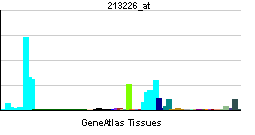Cyclin A2
Cyclin A2, also known as CCNA2, is a human gene.
The protein encoded by this gene belongs to the highly conserved cyclin family, whose members are characterized by a dramatic periodicity in protein abundance through the cell cycle. Cyclins function as regulators of CDK kinases. Different cyclins exhibit distinct expression and degradation patterns which contribute to the temporal coordination of each mitotic event. In contrast to cyclin A1, which is present only in germ cells, this cyclin is expressed in all tissues tested. This cyclin binds and activates CDC2 or CDK2 kinases, and thus promotes both cell cycle G1/S and G2/M transitions.[1]
See also
References
- Pagano M, Pepperkok R, Verde F; et al. (1992). "Cyclin A is required at two points in the human cell cycle". EMBO J. 11 (3): 961–71. PMID 1312467.
- Bailly E, Pines J, Hunter T, Bornens M (1992). "Cytoplasmic accumulation of cyclin B1 in human cells: association with a detergent-resistant compartment and with the centrosome". J. Cell. Sci. 101 ( Pt 3): 529–45. PMID 1387877.
- Faha B, Ewen ME, Tsai LH; et al. (1992). "Interaction between human cyclin A and adenovirus E1A-associated p107 protein". Science. 255 (5040): 87–90. PMID 1532458.
- Paterlini P, De Mitri MS, Martin C; et al. (1991). "A TaqI polymorphism in the human cyclin A gene". Nucleic Acids Res. 19 (9): 2516. PMID 1675006.
- Bandara LR, Adamczewski JP, Hunt T, La Thangue NB (1991). "Cyclin A and the retinoblastoma gene product complex with a common transcription factor". Nature. 352 (6332): 249–51. doi:10.1038/352249a0. PMID 1830372.
- Blanquet V, Wang JA, Chenivesse X; et al. (1991). "Assignment of a human cyclin A gene to 4q26-q27". Genomics. 8 (3): 595–7. PMID 1962755.
- Wang J, Chenivesse X, Henglein B, Bréchot C (1990). "Hepatitis B virus integration in a cyclin A gene in a hepatocellular carcinoma". Nature. 343 (6258): 555–7. doi:10.1038/343555a0. PMID 1967822.
- Jeffrey PD, Russo AA, Polyak K; et al. (1995). "Mechanism of CDK activation revealed by the structure of a cyclinA-CDK2 complex". Nature. 376 (6538): 313–20. doi:10.1038/376313a0. PMID 7630397.
- Xu M, Sheppard KA, Peng CY; et al. (1994). "Cyclin A/CDK2 binds directly to E2F-1 and inhibits the DNA-binding activity of E2F-1/DP-1 by phosphorylation". Mol. Cell. Biol. 14 (12): 8420–31. PMID 7969176.
- Castro A, Jaumot M, Vergés M; et al. (1994). "Microsomal localization of cyclin A and cdk2 in proliferating rat liver cells". Biochem. Biophys. Res. Commun. 201 (3): 1072–8. doi:10.1006/bbrc.1994.1814. PMID 8024548.
- Henglein B, Chenivesse X, Wang J; et al. (1994). "Structure and cell cycle-regulated transcription of the human cyclin A gene". Proc. Natl. Acad. Sci. U.S.A. 91 (12): 5490–4. PMID 8202514.
- Dyson N, Dembski M, Fattaey A; et al. (1993). "Analysis of p107-associated proteins: p107 associates with a form of E2F that differs from pRB-associated E2F-1". J. Virol. 67 (12): 7641–7. PMID 8230483.
- Li Y, Graham C, Lacy S; et al. (1994). "The adenovirus E1A-associated 130-kD protein is encoded by a member of the retinoblastoma gene family and physically interacts with cyclins A and E.". Genes Dev. 7 (12A): 2366–77. PMID 8253383.
- Lees EM, Harlow E (1993). "Sequences within the conserved cyclin box of human cyclin A are sufficient for binding to and activation of cdc2 kinase". Mol. Cell. Biol. 13 (2): 1194–201. PMID 8423786.
- Sebastian B, Kakizuka A, Hunter T (1993). "Cdc25M2 activation of cyclin-dependent kinases by dephosphorylation of threonine-14 and tyrosine-15". Proc. Natl. Acad. Sci. U.S.A. 90 (8): 3521–4. PMID 8475101.
- Carbonaro-Hall D, Williams R, Wu L; et al. (1993). "G1 expression and multistage dynamics of cyclin A in human osteosarcoma cells". Oncogene. 8 (6): 1649–59. PMID 8502485.
- Meikrantz W, Schlegel R (1996). "Suppression of apoptosis by dominant negative mutants of cyclin-dependent protein kinases". J. Biol. Chem. 271 (17): 10205–9. PMID 8626584.
- Poon RY, Jiang W, Toyoshima H, Hunter T (1996). "Cyclin-dependent kinases are inactivated by a combination of p21 and Thr-14/Tyr-15 phosphorylation after UV-induced DNA damage". J. Biol. Chem. 271 (22): 13283–91. PMID 8662825.
- Russo AA, Jeffrey PD, Patten AK; et al. (1996). "Crystal structure of the p27Kip1 cyclin-dependent-kinase inhibitor bound to the cyclin A-Cdk2 complex". Nature. 382 (6589): 325–31. doi:10.1038/382325a0. PMID 8684460.
- Russo AA, Jeffrey PD, Pavletich NP (1996). "Structural basis of cyclin-dependent kinase activation by phosphorylation". Nat. Struct. Biol. 3 (8): 696–700. PMID 8756328.
| This protein-related article is a stub. You can help Wikipedia by expanding it. |


